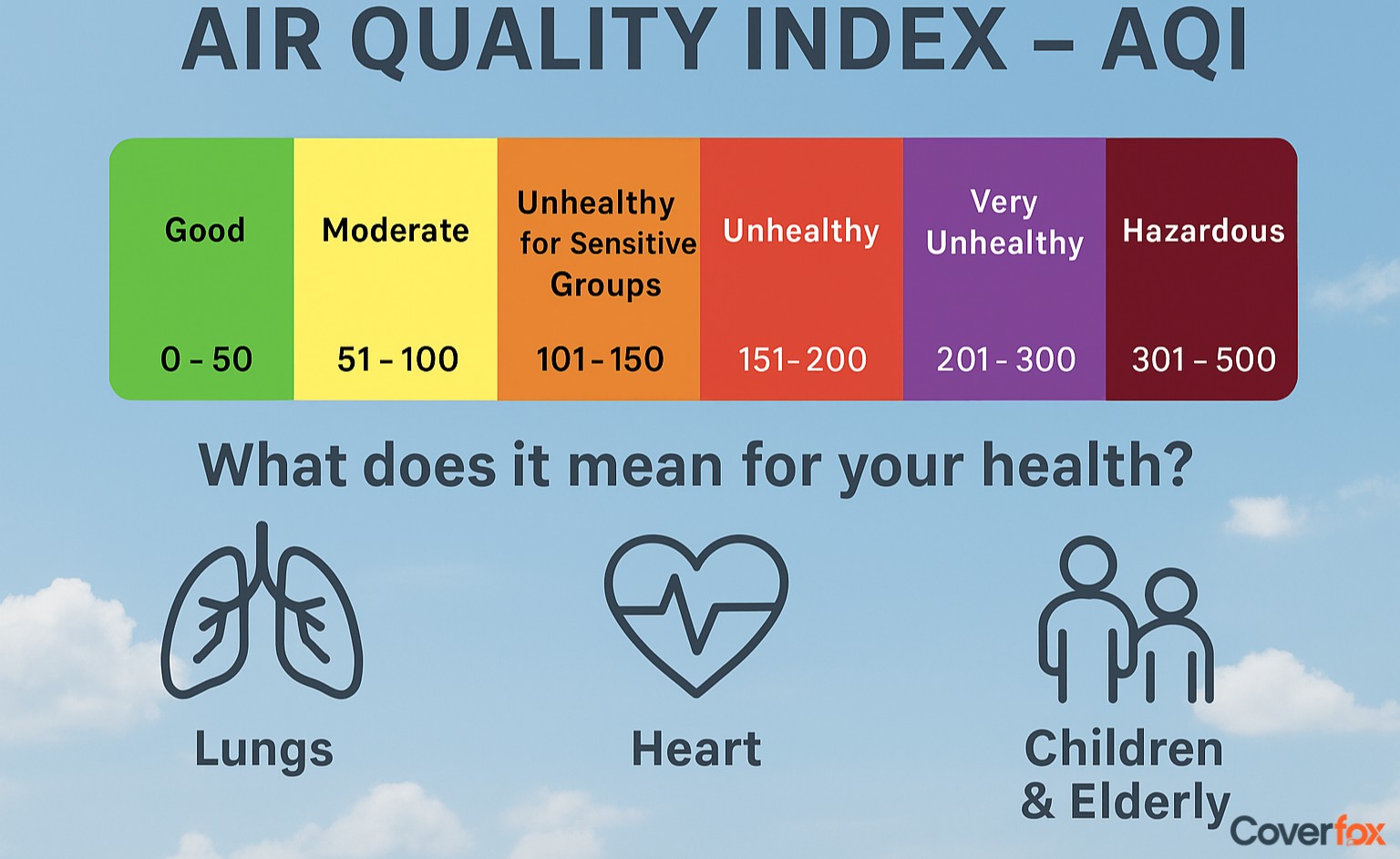Air pollution is a major cause for many health related problems, and one of the major lung cancer initiators. It is very sad to hear everyday that at least one of the Indian cities makes it to the top 5 worst AQI cities in the world.

The most harmful content in polluted air is (PM2.5). PM2.5 are fine particles found in air that are 2.5 micrometres or less in size, which imposes a major threat to our health. Some studies even show inhaling these PM2.5 particles can decrease one’s life expectancy by 5 years! Lets understand about air pollution in detail and why health insurance has become so crucial now.
What Causes Air Pollution in India?
India ranks as the 5th worst air polluted country in the world, and with over 10 cities consistently making a list of top 20 most polluted cities that is updated daily. So what are the root causes of air pollution in India one might ask. The major culprits here are vehicle and industrial emissions. Here are all the root causes of air pollution in India:
Vehicle Emissions
The increasing population in India takes a heavy toll on the AQI (Air Quality Index) of the nation. The number of vehicles on the road now is higher than ever before. With traffic congestion, poor fuel qualities, old out-dated vehicles, the hazardous gas released by these vehicles are one of the major factors causing air pollution in the country.
Industrial Emissions
With constant growth, urbanisation and development, India is progressing, but this has led to an increase in the number of factories, thermal power plants, and small-scale industries that release harmful pollutants such as sulphur dioxide, nitrogen oxides, and particulate matter. Due to lack of proper emission control, these pollutants are just let out in the air (and sometimes even untreated) which causes so many harmful effects making it the leading cause of air pollution in India.
Crop Burning (Stubble Burning)
Crop burning especially during winters have created massive havoc in the northern states of India. Delhi has taken the burn of these stubble burning the most. The smoke emitted and released due to burning of crops contain large amounts of the harmful PM2.5 particulates. This causes air pollution and (AQI) to sky rocket. Delhi has seen the worst AQI in the world during winters and crop burning is one of the culprits.
Use of Solid Fuels for Cooking and Heating
Many families in India, especially in villages and semi-rural areas, still prefer the traditional cooking methods of using wood, coal, dung, etc for fire. This not only creates air pollution in doors, but also leads to air pollution outdoors. Burning solid fuels release large quantities of carbon dioxide, carbon monoxide, sulphur dioxide, and nitrous oxide into the air.
Construction and Road Dust
As India is developing, construction projects are working in full gear. New buildings, road constructions, metro constructions, demolitions, everything is going on around the cities of India. The amount of dust released due to these construction activities is increasing day by day. Mumbai and Delhi have seen the worst effect of this dust in the dust storms that happened quite recently.
Waste Burning
Open burning of plastic, rubber, and other waste materials is still a common practice in many parts of India. This releases a mix of toxic gases and particles into the atmosphere like carbon dioxide (CO2), methane (CH4), nitrous oxide (N2O), and particulate matter (PM).
Geographic and Weather Conditions
Certain areas, particularly in North India, are prone to weather patterns that trap pollutants. Low wind speeds and temperature inversions during winter months prevent pollutants from dispersing, leading to smog and poor air quality.
Recent Studies About the Damaging Health Effects of Air Pollution in India
Impact of air pollution in India can easily be seen in the recent studies from 2024 and 2025 which is quite alarming.
1. Mortality Rate to Air Pollution
A study published in The Lancet Planetary Health in December 2024 estimated that long-term exposure to air pollution contributes to approximately 1.5 million deaths annually in India. This is an alarming figure considering the total mortality in India and steps against air pollution must be taken.
2. Impact of PM2.5 on Mortality Rates
Research shows that every 10 µg/m³ increase in annual average PM2.5 concentration is associated with an 8.6% increase in mortality. Between 2009 and 2019, approximately 3.8 million deaths in India were indirectly caused due to PM2.5 levels exceeding the national standard of 40 µg/m³. This number rises to 16.6 million deaths when compared to the World Health Organization's guideline of 5 µg/m³.
3. Daily Exposure and Acute Health Risks
A 2024 study focusing on ten Indian cities found that about 7.2% of all deaths are attributable to daily exposure to fine particulate matter (PM2.5). Furthermore, research from April 2025 revealed that a 10 µg/m³ increase in PM2.5 levels on extremely hot days correlates with a 4.6% rise in daily deaths, highlighting the risks of air pollution and extreme heat.
4. Broader Health Implications
Respiratory problems aren't the only health implications caused by air pollution. Studies have shown poor air quality causes increased cases of anemia, hypertension, diabetes, elevated cholesterol levels, and mental health disorders.
5. Economic Consequences
Health issues directly cause economic crises. In 2019, India faced an estimated economic loss of $36.8 billion due to premature deaths and morbidity associated with air pollution.
Understanding AQI in India
AQI is a standardized tool to measure the quality of air in India. AQI stands for Air Quality Index. It is calculated by the CPCB by determining various pollutants in the air. It is a numbered and colour denoted index that helps us simplify and understand the air quality.
Here is a table showing what AQI number means and represents
| AQI Range | Air Quality Level | Color Code |
|---|---|---|
| 0–50 | Good | Green |
| 51–100 | Moderate | Yellow |
| 101–150 | Poor | Orange |
| 151–200 | Unhealthy | Red |
| 201–300 | Very Unhealthy | Purple |
| 301–500 | Hazardous | Maroon |
Here is a table showing AQI of different cities in India (14th April 2025)
| City | AQI | Air Quality Level | PM2.5 (µg/m³) | PM10 (µg/m³) |
|---|---|---|---|---|
| New Delhi | 155 | Unhealthy | 63 | 203 |
| Pune | 101 | Poor | 36 | 109 |
| Mumbai | 94 | Moderate | 34 | 116 |
| Kolkata | 94 | Moderate | 29 | 63 |
| Hyderabad | 92 | Moderate | 29 | 78 |
| Ahmedabad | 87 | Moderate | 31 | 79 |
| Bangalore | 80 | Moderate | 23 | 61 |
| Chennai | 72 | Moderate | 20 | 53 |
What Steps Is the Government Taking?
In order to fight against air pollution, Government has tried out various strategies like:
National Clean Air Programme 2019 (NCAP)
The main objective of NCAP is to reduce air pollution (mainly PM2.5 and PM10) particulates in over 100 cities by 2024. It involves city based planning and spreading awareness programmes about air pollution.
Emission Standards
The government has revised emission standards for various industrial sectors and introduced Bharat Stage VI (BS-VI) fuel standards nationwide since April 2020, significantly reducing vehicular emissions.
Promotion of Cleaner Fuels
CNG and LPG, along with ethanol infused fuel have a significantly less pollutant emission than standard fossil fuels. The government is trying its best to promote the use of these cleaner fuels.
Electric Vehicle Incentives
In September 2024, the government approved a $1.3 billion incentive scheme to promote electric vehicles (EVs). The main objective of this scheme is to promote the use of EVs (Scooters, ambulances, etc) to control emissions.
Infrastructure Development
Funds are allocated to reduce smog, and dust in the capital of the country (Delhi NCR) by introducing anti-smog guns, and mechanical road sweepers.
Agricultural Practices
As crop burning is a major contributor to air pollution, the government is providing schemes for farmers who have sustainable practices and use organic fertilizers in order to control air pollution whilst educating and helping farmers.
Mission LiFE (Lifestyle for Environment)
Mission LIFE promotes environment and climate friendly lifestyle changes to the citizens encouraging them to become more sustainable.
The Health Crisis We Are Facing Because Of Air Pollution
Air pollution not only does respiratory damage, but also other health issues related to heart, cancer, mental health, etc. Let us see what air pollution can do to your health:
1. Respiratory Diseases
Asthma, Chronic Obstructive Pulmonary Disease (COPD), and bronchitis along with shortness of breath, wheezing, coughing, throat irritation are the common symptoms of exposure to air pollution.
2. Cardiovascular Issues
Exposure to harmful particles like PM2.5 can cause heart attacks, strokes and hypertension in the human body.
3. Pregnant Women and Infants
Pregnant women are very vulnerable to air pollution and can have implications in the pregnancy like early child birth, low birth weight and even a miscarriage. Similarly infants develop a respiratory disease very early in life if exposed to air pollution constantly.
4. Cancer
According to the International Agency for Research on Cancer (IARC), air pollution is classified as a Group 1 carcinogen. It means that harmful particles like PM2.5 have proven to make cancer cells in the human body, mainly lung cancer.
5. Neurological Effects
Research has shown that air pollution can lead to neurological diseases like Alzheimer's and Parkinson's, and stunt growth in children.
6. Premature Deaths
According to the Lancet Planetary Health Report (2024), air pollution caused over 1.7 million premature deaths in India alone, making it the second leading risk factor for death and disability in the country.
As AQI continues to deteriorate, and severe health conditions continue to rise, having a strong health insurance is a necessity now. Making sure you can cover the high financial costs of treating health conditions caused by air pollution is a must. Health insurance will further safeguard your family's financial condition for a long term. Just make sure your policy includes covers for health conditions caused by air pollution (Most modern insurance policies do cover them).
Challenges in Reducing Air Pollution in India
Even though the government is trying to highlight and deal with air pollution in India, certain factors are making it a challenging task. These factors are:
Growing Population
India is the highest populated country in the world currently, and the population keeps on rising. The rise in population is directly affecting the environment and has created a surge in pollution.
Urbanization
While India is developing, urbanisation has caused many constructions throughout the country. This has led to a depletion of forest reserves, and construction activity has increased dust pollution throughout the nation. Also urbanization leads to industrialization causing more and more industries being set up country-wide, emitting more pollutants than ever.
Agricultural Crop Burning
Even though the government is trying to minimize/change the way stubble burning affects the environment, it is a common practice that has been done in the country since old times and change will take time.
Lack of Public Transport
While metros and mono rails surely helped boost the public transport sector, the rising number of vehicles on the public roads is still a problem. While the major cities do have a good public transport network, the population there is so high that even that is not sufficient and people still prefer their personal vehicles to travel. This has increased a strain on the air pollution throughout the nation.
Lack of Emission Control
The government is constantly updating and putting restrictions on industries, vehicles and factories to either treat pollutants before letting out in the environment or reduce the amount of pollutants to the maximum. However this is still at an early stage and pollution from industries and vehicles still continuously rises.
Limited data and promotion in rural areas
Most of the database is urban-based. Many rural areas still have traditional practices going on which cause indoor and outdoor pollution. Awareness programmes are being held at village level to educate them about air pollutants, however it is still not enough yet.
Solution: How Can I Protect Myself from Air Pollution in India?
It is extremely crucial to protect yourself from air pollution as much as possible to avoid health problems like asthma, COPD, heart issues, etc. By following some small easy to do tips, you can minimize the damage caused to you and your health by air pollution:
- Wear a mask whenever you go outside.
- Cover your hair and body with full clothes and scarves
- Do breathing exercises like pranayam
- Have your vehicle PUC certified
- Dispose garbage properly
- Have a proper health insurance for financial safety
- Try to use ethanol infused fuels instead of normal petrol or better yet opt for EV vehicles
- Support and shift to sustainable habits
- Have air purifiers indoors
Summary
Seeing the bad AQI of our metropolitan cities has made us more aware and vigilant about air pollution. The same goes for the government, Many programmes are being launched by the government to support sustainable habits and spreading awareness about air pollution. We must do our part as well. Let's tackle air pollution together. At the very least, buy health insurance to save yourself from the financial burden air pollution can leave on your health.
Frequently Asked Questions
What are the causes and effects of air pollution in India?
Vehicle emissions, industrial emissions, stubble burning, etc cause air pollution. Air pollution causes respiratory diseases, cardio-vascular diseases, mental disorders, etc.
What are PM2.5 and PM10 particles, and why are they dangerous?
PM2.5 and PM10 are fine particulate matter, 2.5 and 10 micrometres or smaller in diameter, respectively. They can penetrate deep into the lungs and bloodstream, leading to serious health problems like asthma, lung cancer, and cardiovascular diseases.
Which cities in India have the worst air quality?
Cities like Delhi, Ghaziabad, Noida, Kanpur, and Lucknow frequently top the list of the most polluted, especially during winter months.
How is air quality measured in India?
Air quality is assessed using the Air Quality Index (AQI), which tracks pollutants like PM2.5, PM10, NO2, SO2, CO, and ozone. AQI levels are colour-coded from green (good) to maroon (hazardous) to make it easier to understand
What steps is the Indian government taking to combat air pollution?
The government has launched programmes like the National Clean Air Programme (NCAP), promoted electric vehicles (EVs), regulated industrial emissions, and subsidised alternatives to stubble burning. Urban policies also encourage better waste management and public transport use.
Can health insurance help protect individuals from the effects of air pollution?
Yes, many health insurance policies now cover treatment for pollution-related illnesses such as asthma, COPD, and respiratory infections.





